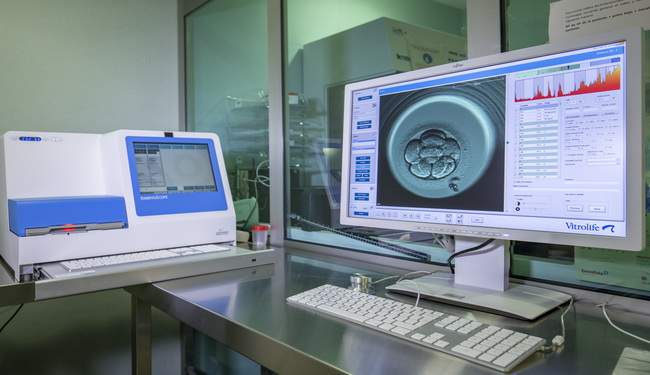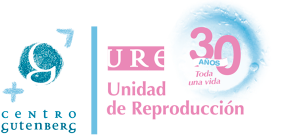Embryo freezing: frequently asked questions about this assisted reproduction technique

The freezing of embryos by vitrification, or ultra‑rapid freezing, is one of the assisted reproduction techniques we perform at URE Centro Gutenberg. It’s a very useful procedure as it allows us to preserve the embryos that aren’t going to be transferred in the same cycle. This may be because there are additional embryos remaining after the embryo transfer is carried out, or because the woman’s endometrium isn’t prepared for an embryo transfer. In both cases, the embryos are vitrified so that they may be transferred in a later cycle.
Our experience tells us how often we are able to freeze remaining embryos. This is possible around 20% to 30% of the time when carrying out IVF treatment with own eggs, and around 40% to 50% of the time when carrying out treatment with donated oocytes, or egg donation.
You most likely have doubts about this assisted reproduction technique. We are aware that it usually leads to many questions, and these have become a recurring topic in our fertility consultations. That is why today we would like to answer several of these frequently asked questions for you.
How are the embryos frozen?
Vitrification is an ultra‑rapid freezing system in which we introduce the embryos into liquid nitrogen. With this technique, the temperature of the embryos instantly drops from 23 degrees to negative 196 degrees.
This extremely elevated cooling speed, along with the use of cryo‑protectors, prevents the formation of ice crystals, in turn preventing damage to cell structures. This way, upon thawing, the embryos will resume cell division and development without disruption.
Do the embryos offer the same chances of success once they are thawed?
Nowadays, using frozen embryos from a cycle of In Vitro Fertilisation gives us practically the same likelihood of pregnancy as when fresh embryos are used.
In fact, an increasing number of studies are demonstrating similar success rates between fresh and frozen embryos. There are even authors who indicate higher pregnancy success rates when using frozen embryos.
How long can embryos remain frozen?
Once they’ve been vitrified, embryos can remain in storage in this state for an unlimited amount of time.
Additionally, the amount of time the embryos remain frozen will not impact their quality.
How is a cryotransfer, or a frozen embryo transfer treatment, carried out?
A frozen embryo transfer is more straightforward and less expensive as it does not involve the same preparation as a cycle of in vitro fertilisation which requires daily injections, sedation, the operating theatre, etc.
This treatment consists in preparing the endometrium to receive the embryos. There are two options: in a natural cycle, or in a stimulated cycle involving the repeated administration of the hormones estradiol and progesterone.
Both methods of endometrial preparation have shown to be equally effective in terms of results. For this reason, at URE Centro Gutenberg choosing one method or another will be exclusively based on medical criteria and on the comfort and safety of the patient.
What quality do frozen embryos usually have?
Embryo quality at the time of thawing is the same as when they were initially frozen. This means that the embryos will present the same morphological characteristics.
In rare cases embryo quality may be altered upon thawing or the embryos may not survive the thawing process.
What is the survival rate of frozen embryos?
The success rate of this technique will depend on embryo quality and on the embryo’s ability to survive the freezing process. Here we can clearly see the difference between embryos from a cycle of in vitro fertilisation with own eggs compared to donated oocytes, or egg donation.
The survival rate is around 97% when the embryos have come from a cycle of egg donation, and around 90% when they’ve come from a cycle of IVF with own eggs. The likelihood of achieving a viable pregnancy, on average, is around 51%.
What happens if I no longer need the frozen embryos?
According to Spanish Law on Assisted Reproduction (Law 14/2006), the possible uses that can be given to the cryopreserved embryos remaining following a cycle of IVF are clear: they can be used in the future by the same woman/couple, they can be donated for reproductive or scientific purposes, or they must be destroyed.

